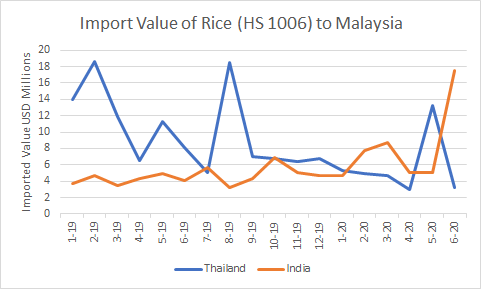India Becomes a Rising Rice Sourcing Destination for Malaysia
Amongst the protectionist measures which have caused major rice producers - Myanmar, Vietnam, and Cambodia - to safeguard their supplies of rice, India emerged as an attractive sourcing destination, as the country remained open for exports. For Malaysia, the revitalization of the rice trade with India, which has been stagnant over the years, also represents its hope to rebuild its relationship with India after experiencing a fallout.
Protectionist Policies Deter Malaysia from Traditional Imports
Since the outbreak of the coronavirus, countries have one-by-one rushed to set export restrictions on staple foods. Vietnam moved to halt any export contracts from occurring, Myanmar paused rice export licenses from being issued, and Cambodia had ceased exports of non-fragrant rice and paddy. These forms of restrictions were loosened soon after in some form, but have left potentially lasting effects on the rice trade.
With the absence of Vietnam, the third-largest rice exporter, countries vying for the spot have quickly come to absorb market share, including India. Malaysia was placed in a unique position, where its main import destinations have been Vietnam, making up 44.5% of Malaysian imports, as well as Thailand, which made up 26.6%, in 2019, as per Tridge Data. Vietnam was not a viable option for imports, and while Thailand had no export restrictions, it had stockpiled a great number of its domestic supplies, which left India, Malaysia's third-largest importer, to meet the demand.

Source: Trade Map.
India also had comparatively lower prices than the rest of the countries, allowing Malaysia to import a record amount of rice in 2020, where Malaysia contracted 100K MT of rice from India in May and June alone. Compared to Thailand, which had experienced a 60% decrease in June 2020 in import value compared to the same period in 2019, India witnessed a 335% increase.
Myanmar and India’s Relationship Patch Up
Malaysia and India’s relationship has been rocky over the years, where disputes over India’s policies of Muslims have sparked India’s restriction of Malaysian palm oil imports. However, with the rollover into the new administration in Malaysia after the collapse of the old in February, the Malaysian government has put a priority on improving relations with India, and expanding rice imports from India indicated a step forward to this goal. Repatching of many soured relationships was not a one-time occurrence for India this year, as China had imported rice from India after 35 years of little to no trade even after their long history of conflict.
Throughout the new year, Malaysia’s rice imports from India are likely to hold steady, especially as Thailand has been suffering from lower than usual domestic production and consequently higher prices. Even Vietnam has resorted to sourcing from India after decades, due to the decreased availability of global rice supplies.
Sources
- FAO. Why export restrictions should not be a response to COVID-19: Learning lessons from experience with rice in Asia and the Pacific.
- Reuters. "Exclusive: Vietnam buys Indian rice for the first time in decades - industry officials."
- Malay Mail. "Malaysia signs record rice import deal with India, say exporters."





